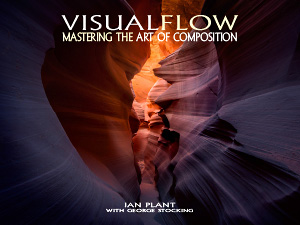I’ve read many books on composition over the course of my 35 years in photography. I know the rules very well, use them daily, and preach their use to my students and fellow photographers. I believe that when a photographer starts understanding and using elements of composition, he or she hits one of those monumental milestones in the craft. The moment when “taking pictures” becomes “making photographs.”

Recently, I read Visual Flow: Mastering the Art of Composition, written by Ian Plant (with George Stocking). Of all the books I’ve read on photographic composition, Visual Flow is by far my favorite. I wish I would have had it 35 years ago.
Ian takes a new approach to composition that I find refreshing. He doesn’t say, “here are the rules of composition…now follow them and make great images.” Rather, Ian stresses in chapter one, “There are no such things as the “rules of composition!” The rules that we all know and love are here because of what the master painters and photographers have done in the past. They set the standards of what works and what doesn’t. “The “rules” flowed from [their] successful compositions.”
In Visual Flow, Ian teaches “abstract thinking” and “visual flow.” He explains why things work compositionally in photography, and in artwork as a whole. Using a technique called “telestrator,” Ian uses colored lines and arrows to map out the compositional elements so that you better understand the concepts. Think football coach having a chalk talk with his team and illustrating the plays. That’s telestrator. I’ve never seen it used before in a photography book, but it is genius.
At 288 pages, Visual Flow is broken into six fantastic chapters covering composition elements, common shapes used in composition, the illusion of depth, the division of space, chaos reduction, and finally mood. Each chapter is color-coded and marked with a dot pattern in the upper right-hand corner indicating the chapter. Near the beginning of each chapter, you will find something similar to a mind map illustrating what you can expect to learn. At the end of each chapter, Ian has a page of the “Top Five Lessons,” summarizing what was covered. Visual Flow is very well thought out, with a beautiful design.
If nothing else, Visual Flow is a gorgeous book. The photography used to illustrate this book is breathtaking. Currently, Visual Flow is only available as an eBook in PDF form, which is really too bad. It could easily be displayed as a coffee table book. Even if someone didn’t know anything about photographic composition, they would be thrilled to thumb through the book, looking at the pictures. Maybe you could just lay your iPad or tablet on the coffee table.
I couldn’t decide who the target audience was for Visual Flow. Is it an advanced composition book for enthusiast and professional photographers? Or, is it a composition primer for the beginners and amateurs, teaching them what makes a good photo before they get trapped by the rules of composition? In the end, I decided that I highly recommend photographers of all levels read and study Visual Flow.
For the advanced enthusiasts and professionals out there, Visual Flow will help solidify your understanding of photographic composition and make you stronger as a photographer. For the beginning and amateur photographers out there, study the photos and Ian’s telestrator lines. I guarantee your photography will take a huge leap forward. Good photographic composition is so important, and Visual Flow will take you beyond understanding the rules of composition.
The only negative thing that I could possibly say about Visual Flow is that the photography is too good. The level of photography used in this book could easily intimidate newer photographers. Don’t let that stop you from reading this book though. Ian points out in the introduction that he struggled coming up with all the photos to illustrate this book. In fact, rather than defer the book an additional year, he chose to bring his mentor George Stocking in to collaborate and supply additional photos. So, to any photographers out there who might be intimidated by the quality of the images in this book, remember that these photos represent a lifetime of shooting by both Ian Plant and George Stocking. I can almost guarantee you that both men have tens of thousands, if not hundreds of thousands, of images sitting in their offices that did not make the cut for a book of this caliber. Also, keep in mind that these two gentlemen have paid their dues in photography. They have great images because they spent countless hours, days, months, and years out shooting.
Update:
A companion book has been released by Ian Plant titled Visual Flow Companion, Volume 1. You can read more about it on my site at this link: https://www.wesgibson.com/2013/12/visualflowupdate/
